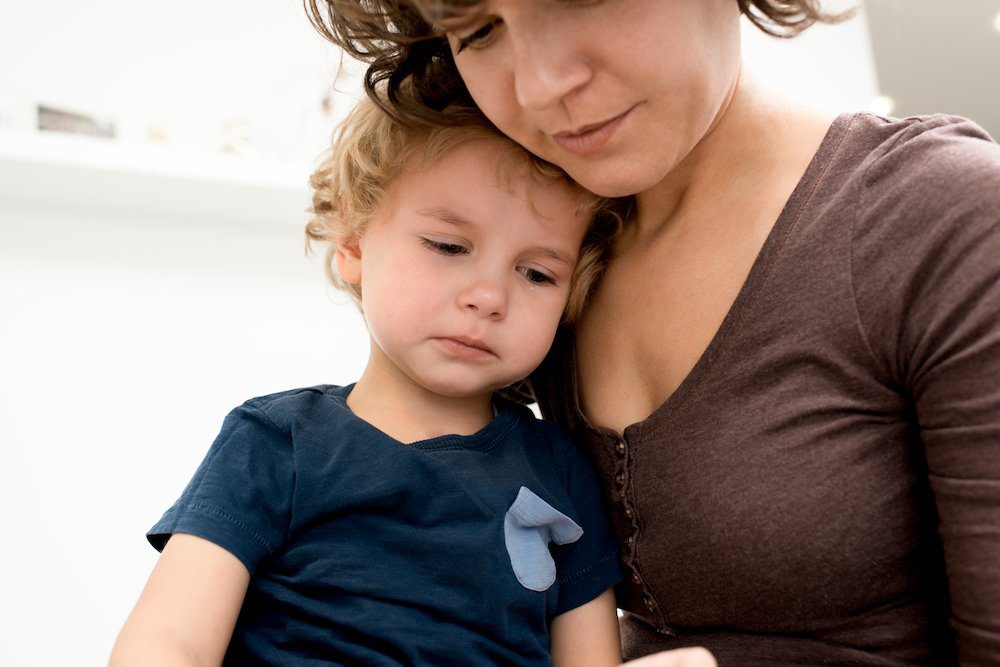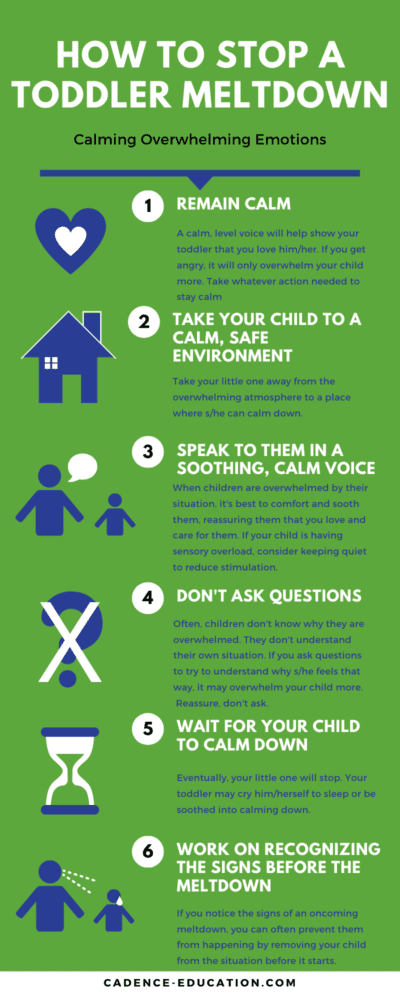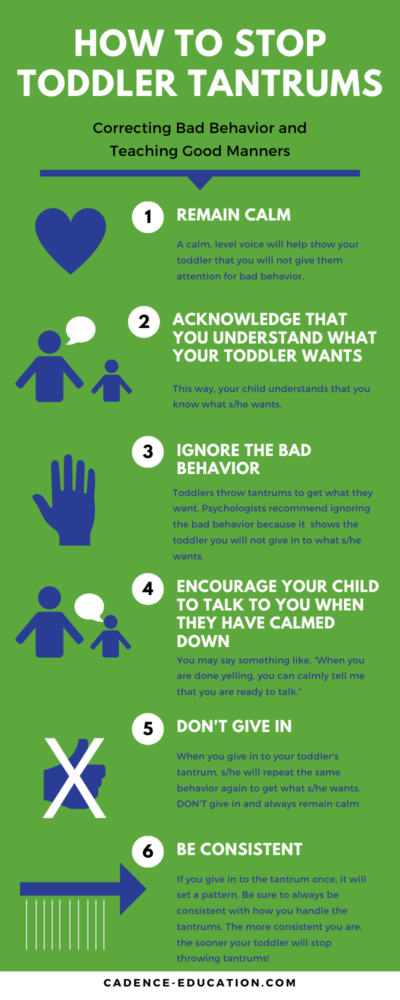Is your child throwing temper tantrums?
Most toddlers do!
For parents, however, it can be irritating and challenging to deal with. Perhaps you are wondering what the norm is for temper tantrums, how they differ at each age, and how you can manage them as a parent.
In this comprehensive guide, you’ll learn all about temper tantrums at each age and how you can handle them! Read on to learn more!
Table of Contents
- Tantrum vs. Meltdown – What’s the Difference?
- Why Do Toddlers Throw Tantrums? An Explanation for Every Age
- How to Stop Tantrums
- Advice for Parents: How to Deal With Tantrums
- Toddler Tantrums: When to Worry
Tantrum vs. Meltdown – What’s the Difference?
Tantrums and meltdowns may look very similar at a glance. In fact, many people think they are the same thing. Nonetheless, we’re here to correct this—tantrums and meltdowns are not the same.
Why does this distinction matter?
Because one is on purpose and the other is not. If you punish children for involuntarily breaking down, you could harm them emotionally. Let us explain.
What is a Tantrum?
A tantrum happens when a child is trying to get something s/he wants or needs. The child will have an outburst that involves yelling and crying. When a child has a tantrum, s/he may even stop in the middle to see if the parent or caregiver is looking at him/her and then continue with the outburst.
This is not an appropriate way to express feelings. Often, children will stop when they get what they want or when they realize that having a tantrum won’t solve the problem.
What is a Meltdown?
A meltdown happens when a child is overwhelmed by sensory overload. Meltdowns may involve yelling, crying, or shutting down.
For example, meltdown may happen after a busy day at an amusement park. While a child may have had tons of fun, s/he was also processing a lot of sounds, sights, tastes, and textures.
Your child can not control a meltdown that is a result of sensory overload.
How to Determine If Your Child is Having a Tantrum vs. Meltdown
If you are having a difficult time trying to determine whether your child is having a tantrum or a meltdown, try to evaluate your child’s situation.
For instance, what exactly are you doing when your child has a tantrum or meltdown? You may be in a busy place, such as a mall. Perhaps you and your little one ran errands all day, and now your child is tired. That’s a meltdown.
On the other hand, if your child wants you to buy him/her something and you say no, your child is probably throwing a tantrum, trying to persuade you buy it for them.
To truly determine how your child is reacting, though, tune in to your child’s feelings. You may even sense when these intense feelings are coming on and work to prevent them from erupting by helping your toddler manage his/her complicated emotions or distracting him/her.
How to Deal with Meltdowns
When your child is having a meltdown, help your child find a safe, quiet place to calm down.
For example, if you are in a store while your child starts having a meltdown, step outside or go to your car until your child can calm down.
Be a calming presence to your little one. Try not to talk too much, or keep your voice soft and soothing. Remember, a meltdown is caused by overstimulation. So try to reduce the stimulation to stop the meltdown.
What Does it Mean When Your Child Has Meltdowns Regularly?
If your child seems to be having meltdowns regularly and without apparent sensory overload, it may be due to stress.
Could your child be under stress? If so, what could be causing the stress? Sometimes, it may be because parents are fighting, one parent is sick, or there is some disharmony in the house.
Keep in mind that even toddlers can sense when parents are stressed out. If you are stressed, it may inadvertently cause meltdowns. If that is the case, talk with your child. Be as honest with them as you can, but use language s/he can understand.
Healthy communication will help to ease any anxiety they might have. Be a comforting, calming presence to your little one, showing him/her that you love him/her.
Why Do Children Throw Tantrums? An Explanation for Every Age

Temper tantrums can be stressful for both the parent and child. Nonetheless, as the CDC suggests, understanding and responding appropriately to the tantrum can improve behaviors over time. So, before you throw your hands up in defeat, learn about the various reasons why children of different ages throw temper tantrums. After, we’ll discuss how to handle sporadic tantrums.
Baby Tantrums

Of course, all babies cry. Usually, it’s because they have a dirty diaper, are hungry, or are tired. Most parents know what it sounds like when their baby is crying because s/he is hurt or uncomfortable. If your baby is crying because of any of these reasons, it’s not considered a tantrum.
Remember, too, that a baby’s only form of communication is crying. If your child is under one year old, s/he is probably not throwing a temper tantrum. Rather, your little one may be tired, hungry, or getting sick. If your baby is often crying and you are unsure why talk to your pediatrician.
1 Year Old Tantrums
 Most babies will throw their first tantrum around one year old, give or take a few months. So rest assured that this is normal behavior!
Most babies will throw their first tantrum around one year old, give or take a few months. So rest assured that this is normal behavior!
In fact, most toddlers throw tantrums because they are trying to express themselves. Toddlers have a limited vocabulary at this age, making it harder for them to express themselves properly.
Therefore, your one year old may be throwing a tantrum simply because s/he is hungry or tired. On the other hand, your child might be having a tantrum because s/he is frustrated or jealous.
2 Year Old Tantrums

The terrible twos! There’s a reason for this alliterate term. Two-year-olds are usually the most prone to throwing temper tantrums.
Just like the one-year-old, a two-year-old will often throw a tantrum because s/he cannot communicate what s/he wants effectively. Sometimes, your child might not even know what s/he wants. Sometimes, it can become overwhelming for them, and they have a meltdown.
On the other hand, if your child is throwing a temper tantrum because s/he is frustrated because s/he isn’t getting his/her way, you must stand your ground. Don’t encourage bad behavior.
3 Year Old Tantrums

Tantrums for your three year old will usually be caused by the same things that trigger a two-year-old’s tantrum. In other words, your three-year-old may be frustrated, or s/he is having a difficult time expressing him/herself.
Another cause of toddler tantrums is unrealistic expectations or rigid rules. If a child feels that you are putting too much pressure on him/her, it may cause a tantrum to ensue. It’s crucial to find the right balance as a parent. At the same time, your child must learn how to express his/her feelings without exploding.
4 Year Old Tantrums

By this age, temper tantrums should decrease because at this age children are able to communicate their feelings.
However, some four-year-olds still throw tantrums for the same reasons a two or three-year-old will. Often, adults may think that their four-year-old is mature enough not to throw a tantrum. Sadly, if you have thought this, you may be overestimating your little one.
It’s a good idea to talk to your child and help him/her to understand that s/he is in charge of his/her emotions, rather than the feelings being in charge of your child.
Additionally, your child may have specific triggers that cause stress. If certain situations, classes, or activities trigger a tantrum, talk with your child about it. Is it too much for them to handle right now?
Lastly, four year olds could throw temper tantrums because they want something they can’t have.
5 Year Old Tantrums

Now that your child is five years old and well on his/her way to entering elementary school, most tantrums will have ceased by now. However, some children still tend to throw tantrums. Don’t worry—it’s still normal at this age!
Your five year old could be throwing a tantrum because s/he wants something s/he cannot have, is stressed out, hungry, or tired.
If you know these are not the causes of the tantrum, talk to your child to see what may be stressing him/her out. It could be school, family problems, or something else.
On the other hand, if your child is being stubborn or is upset because s/he isn’t getting his/her way, it’s probably because you’ve told him/her no. Don’t give in if your child throws a tantrum. It is more productive to ignore bad behavior.
6 Year Old Tantrums
 If your child is still throwing tantrums by the age of six, it could be because they have a hard time controlling their emotions. Some children feel emotions more strongly than other children.
If your child is still throwing tantrums by the age of six, it could be because they have a hard time controlling their emotions. Some children feel emotions more strongly than other children.
Another reason may be because your six-year-old has a difficult time explaining his/her feelings or experiences.
Other triggers may be anxiety over certain activities or situations like trouble in school, or overstimulation.
Talk to your child to try to understand what is bothering him/her. Try to pinpoint what situations, activities, or experiences may be causing the anxiety, overstimulation, or loss of emotional control.
How to Stop Temper Tantrums

Identify and Stop Baby Tantrum Triggers
As said before, baby tantrums are inevitable. Children this small can not effectively communicate their problems or thoughts.
For this reason, it is up to the parent to investigate and find the source of their grief. The following questions are a few things you should consider if your baby is throwing a tantrum:
- Is your little one hungry, tired, or does s/he have a messy diaper?
- Is your little one too hot or too cold?
- Could s/he be getting sick?
Some babies throw a tantrum because they are frustrated. If that is the case, help your baby achieve his/her goal or remove the frustration. If your baby is afraid or anxious, cuddle, and comfort your little one, removing him/her from the stressful situation.
Remember, your baby cannot yet communicate with you. The only way s/he can express him/herself is to cry. If your baby is crying intensely or excessively, it’s probably because s/he is trying to tell you something.
However, if your baby is crying because s/he was playing with a confiscated toy, try to find a distraction for him/her. For instance, get your baby excited about a different toy.
Stop and Prevent Further Toddler Temper Tantrums
Whatever you do, remain calm. If you try to punish or threaten your child while s/he is already in the throes of a tantrum, the tantrum may escalate. As mentioned, children who have lost control of their emotions may feel anxious or afraid of how they feel. If you yell, it may make the situation worse. Therefore, your first step should be calming down your child without giving in to bad behavior.
Here is how to stop each type of tantrum:
- Fatigue/frustration tantrums. Give your child a nap or snack, offer help, or take a break from whatever your toddler is doing.
- Attention-seeking/demanding tantrums. This is often a response to you saying no. Smile, reassure your child you love him/her, make him/her feel safe, and calmly offer to talk to him/her again when s/he is calmer. You may say something like, “When you are done yelling, you can calmly tell me that you are ready to talk.”
- Refusal tantrum. This happens when the child says no, usually because you’ve asked him/her to do something s/he doesn’t want to do. Try to go easy on your little one if the situation isn’t too critical. If it’s snack time and your child doesn’t want to eat, for instance, don’t force him/her to do it anyway if it will trigger a tantrum.
- Disruptive tantrums. These usually occur when children are acting up. Place your child in a room by him/herself and give him/her a time out for a few minutes. If you are not at home, take your child outside. Help your child to understand that s/he will not get attention from you or anyone else from misbehaving. Sometimes, toddlers will check to see if you are paying attention to them when they are throwing a tantrum.
- Rage tantrum. This is when your child loses control physically and emotionally. S/He may scream, kick, or hit, potentially harming him/herself or others. Some toddlers don’t understand the intensity of their own emotions. If you are able, hold your child securely and tell him/her that you will continue doing so until s/he calms down and gains control over him/herself.
Even more, according to the Centers for Disease Control and Prevention, ignoring a temper tantrum can be a positive way to stop them.
Why?
It shows your child that you will not give him/her attention for misbehaving.
If your child is old enough to communicate effectively, talk to him/her. Your child may experience tantrums because s/he is stressed about something s/he is having a hard time explaining.
How to Stop Toddler Bedtime Tantrums
Toddler bedtime tantrums can make bedtime very difficult! Many children make bedtime difficult because they don’t want to go to bed. This is a type of refusal tantrum.
Toddler bedtime tantrums are very common. In fact, bedtime is a learned routine and will get better with consistency.
The best way to stop it is to develop a regular bedtime routine and stick to it every night. For instance, your child’s bedtime routine may start with taking a bath, then move on to brushing teeth, putting PJs on, and reading a bedtime story. Make sure that your child’s bedtime routine is the same every night and takes place at the same time. This way, your child will get used to the idea of winding down for sleep.
Be sure to explain to your toddler what happens next in the routine so s/he knows each step before it happens.
Additionally, if your child doesn’t seem tired at bedtime, you may consider getting rid of nap time. Every child is different, but most children outgrow naps around three years of age. If you are unsure about whether or not your child should have nap time, ask your pediatrician.
Lastly, be sure to reward good behavior, such as with a reward chart. For instance, when your toddler goes to bed without throwing a tantrum all week, perhaps they can stay up an extra thirty minutes on Saturday night, get a new toy, go out for ice cream, get a new bedtime book, or enjoy a trip to the park. A reward chart may encourage good behavior.
Remember, don’t give in to the tantrum. If you allow your child to stay up when they throw a tantrum, s/he will no doubt feel that if s/he throws a tantrum every night, s/he can stay up. This will only start bad habits. Always remember to remain calm and do not encourage bad behavior.
Advice for Parents: How to Deal with Tantrums
Some toddlers throw tantrums often. Therefore, you will have to know more than how to stop tantrums; you also need to know how to deal with toddler temper tantrums.
For instance, it’s always a good idea to have a plan for when your child has a meltdown or tantrum (see the infographics). Your goal should always be to keep your child safe and guide his/her behavior, so the temper tantrum is less likely to happen in the future.
Additionally, find ways to remain calm and keep your composure. Dealing with tantrums can be exhausting and irritating. However, when you yell at your child or give in to your toddler’s demands, it can worsen the situation and even teach your child bad habits.
If tantrums continue to get worse or are becoming too much to bear, you may need to talk to your child’s pediatrician. Keep reading to learn about some tantrum red flags to look out for.
Toddler Tantrums: When to Worry
 According to WebMD, there are five red flags when it comes to toddler temper tantrums and when to worry. Here they are:
According to WebMD, there are five red flags when it comes to toddler temper tantrums and when to worry. Here they are:
Firstly, if your toddler is showing aggression toward you, a caregiver, or an object during all or most of his/her tantrums, it may signal a disruptive disorder.
Secondly, children who harm themselves deliberately during a temper tantrum (biting or scratching themselves, banging their heads against a wall, or kicking something in an attempt to hurt themselves) were more likely to have major depression.
Thirdly, preschoolers who have, on average, ten to twenty tantrums a month at home or who have more than five tantrums a day outside of the home may have a serious psychiatric problem.
Fourthly, if children constantly have temper tantrums that last more than twenty-five minutes, it may be a sign of another underlying problem. Keep in mind, though, that a child may have a very long tantrum and be completely normal. It’s when a child continuously has tantrums exceeding twenty-five minutes that a child may have another issue causing it.
Fifthly, if a child cannot calm him/herself down after a tantrum, it may be another red flag that a problem is occurring. These children often require some bribery or physical removal from the situation to calm them down.
If your child is experiencing one or more of these red flags, it may be a sign that s/he has some mental health problem. So what should you do?
Talk to your child’s pediatrician to see if there could be an underlying problem. Also, consider visiting a pediatric neuropsychologist for a broad assessment or see a child psychologist, who will help the child develop emotional control.
Rest assured that most children have tantrums. In fact, seven out of ten 18-24-month-olds throw tantrums, and about 75% of 3-5-year-olds have tantrums as well.
Does Your Child Go to a School that Encourages Good Behavior?
Sometimes, schools and daycares do not have the best system in place when a toddler throws a tantrum. For instance, some teachers may think the child is acting up and discipline him/her for throwing one. Other teachers may be too lenient. If your little one throws a tantrum every day before going to school, the school may be overwhelming or stressful for your little one.
So what’s the solution?
You must find a school or daycare program that encourages good behavior through positivity and a nurturing, loving atmosphere.
For example, Cadence Education makes this a priority to implement in every classroom. Through exceptional education, fun-filled days, and an environment as nurturing as home, your child will no doubt feel safe, happy, and comfortable at Cadence Education!
Additionally, these schools offer parents meaningful communication, so you are always up-to-date with your child’s behavior, activities, and personal growth. Through weekly emails and monthly progress reports, you will always be involved in your child’s daily activities.
With daycare programs for babies and toddlers, as well as kindergarten-readiness programs, your little one will surely get the fun educational experience they deserve.
Find a school near you and schedule a visit today!




